SINGLE-STRINGER STAIRCASE
A single-stringer staircase is a special kind of stairs that has only one big support beam in the middle to hold up all the stairs. They are cool for a few reasons!
First, they look modern and stylish, which means they can make a home or office look super fancy. They can also be made in different shapes and sizes to fit perfectly in a building.
Another cool thing about single-stringer staircases is that they don't take up too much space. That means they can fit in small houses or buildings well.
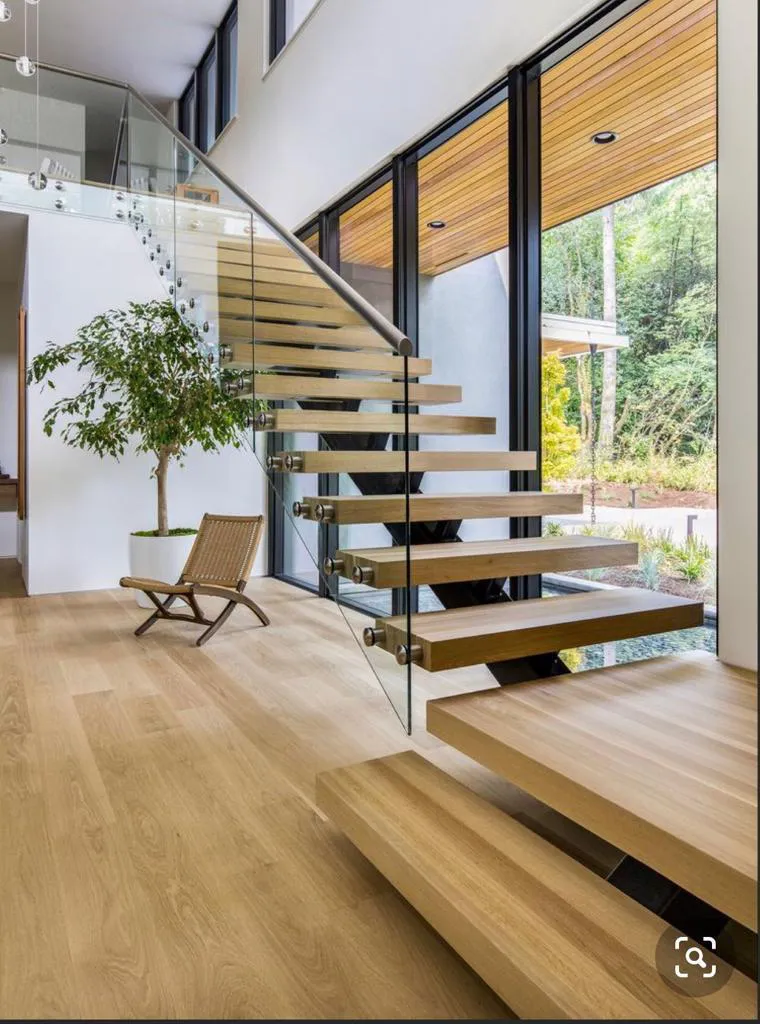
-
Sleek and modern design:
Single-stringer staircases have a minimalist and modern look that can add a stylish touch to any home or office space.
-
Natural light:
The open design of a single-stringer staircase allows natural light to flow through the space, creating a bright and airy atmosphere.
-
Easy to clean:
The open design of single-stringer staircases makes them easy to clean, as there are no enclosed areas that can accumulate dirt or dust.
-
Space-saving:
Single-stringer staircases can be designed to take up less space than other types of staircases, which makes them a good option for small homes or buildings.
-
Customizable:
Single-stringer staircases can be customized to fit the unique needs and preferences of the owner. They can be designed in different materials, such as wood, metal, or glass, and can come in straight, dogleg, u shape.
-
Energy-efficient:
Single-stringer staircases can allow more natural light to enter a building, which can help reduce the need for artificial lighting and save energy.
DOUBLE-STRINGER STAIRCASE
Double-stringer staircases are super cool and have lots of benefits. Now, some staircases have only one big support beam, called a single-stringer staircase, that holds up all the stairs. But a double stringer staircase has two of those big beams instead of one, which makes it extra strong and safe to use. That means you can climb up and down without worrying about the staircase breaking or wobbling. Double-stringer staircases can look really cool too, with different shapes and designs that can match the rest of the building. Plus, because they're so strong, double-stringer staircases can last for a long time without needing repairs. Isn't that neat? So, next time you see a double stringer staircase, you'll know why it's such a good choice!
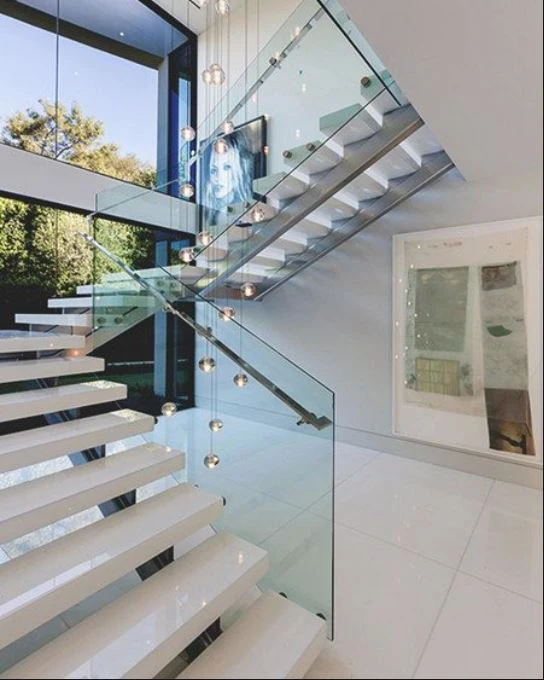
-
Enhanced structural stability
Double-stringer staircases offer enhanced structural stability as compared to single-stringer staircases. This is because they have two supporting beams (stringers) instead of one, which distribute the weight of the staircase more evenly and reduce the risk of structural failure.
-
Aesthetic appeal:
Double-stringer staircases can be designed to have a modern and sleek look, which can add an elegant touch to any home or office.
-
Design flexibility:
Double-stringer can come in straight, dogleg and u-shape.
-
Natural light:
The open design of a double-stringer staircase allows natural light to flow through the space, creating a bright and airy atmosphere.
-
Easy to clean:
The open design of double-stringer staircases makes them easy to clean, as there are no enclosed areas that can accumulate dirt or dust.
-
Improved safety:
Double-stringer staircases can be designed with a wider stair and riser, which can improve safety by reducing the risk of slips, trips, and falls.
-
Customization:
Double-stringer staircases can be customized to fit the unique needs and preferences of the owner. They can be designed in various shapes, sizes, and materials to complement the overall design of the space.
-
Durability:
Double-stringer staircases are generally made of high-quality materials that are durable and long-lasting. This means that they require minimal maintenance and are less likely to need repairs or replacements in the future.
CANTILEVER STAIRCASE
Aesthetically pleasing: Cantilever staircases are visually striking and elegant in appearance and can add a touch of sophistication to any space.
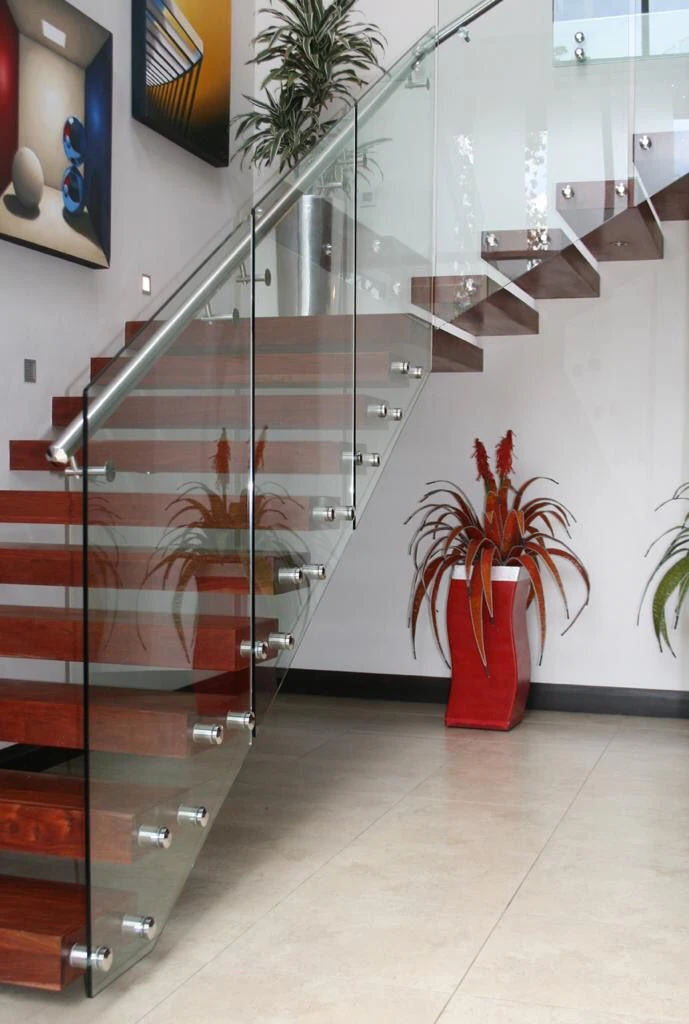
-
Preparation of installation:
A previously planned double wall (preferable a triple wall) on the closed side of the cantilever staircase. This wall should be built beforehand with cavities. Securely fixed steel supports are to protrude from these wall cavities. Boxed timber stairs to fit snugly over these steel supports to make them non-visible.
-
Complexity of installation:
Cantilever staircases require a high level of expertise and precision during installation, and any errors can compromise the structural integrity of the staircase.
-
Natural light:
The open design of a cantilever staircase allows natural light to flow through the space, creating a bright and airy atmosphere.
-
Easy to clean:
The open design of cantilever staircases makes them easy to clean, as there are no enclosed areas that can accumulate dirt or dust.
-
Potential for vibration:
Cantilever staircases may experience vibration due to the lack of supporting structures, which can create a feeling of instability for some users.
-
Limited weight capacity:
Cantilever staircases have a lower weight capacity compared to traditional staircases, lack of visible stringer supports means they may not be suitable for heavily trafficked areas or for carrying heavy objects. Heavy balustrade, such as glass is not advisable.
-
Higher cost:
Cantilever staircases can be more expensive to design, and build compared to traditional staircases due to the need for specialized materials and secure fixing to the wall side.
CONCRETE SHUTTER CAGED STAIRCASE
Concrete shutther caged staircases are made from a really strong material called concrete. They are great for big buildings like offices or factories because they can handle lots of people going up and down them all the time. They can be designed in different shapes, for example straight, curved, or spiral. This means they can look really cool and fit in with the rest of the building. They don't need a lot of repairing or maintenance because they are strong and can handle different kinds of weather. They also have something called a steel cage around them which makes them even stronger. It takes a while to build these stairs because there are a lot of things involved, like making the steel cage and pouring and curing the concrete. They are heavy, the building needs to have a strong foundation and extra support. One thing to remember is that it can be more expensive to build these stairs compared to more modern kind of stairs because they need more materials and work to make them.

-
Durability:
Concrete shutter caged staircases are extremely durable and strong. They can withstand heavy traffic and frequent use, making them ideal for commercial or industrial buildings. They are suitable for inside and outside the building.
-
Design flexibility:
Concrete shutter caged staircases offer a high degree of design flexibility, making it possible to customize the staircase to meet specific design requirements. Various shapes as straight, dogleg, u shape, curved, helix and spiral staircases are possible.
-
Minimal maintenance:
Concrete shutter caged staircases require minimal maintenance, as they are less prone to wear and tear and damage from weather conditions.
-
Shutter cage:
The steel cage is normally cladded with mesh to apply plastering. Then there are also the Pan System available, which the steel cage is cladded with steel plate on the outside that can be painted or cladded with tiles or other materials, also on top of the stairs and landing.Installation time: The installation of a concrete shutter caged staircase can take longer than that of other types of staircases, as it involves multiple stairs, including, the constructing the shutter, building of the metal cage and cladded it with steel mesh or plate, arranging and fixing of reinforcing, the pouring and curing of the concrete. The curing and hardening process typically takes several days. In this way, the steel cage form work remains part of your structure, making it stronger, with no additional shuttering required.
-
Weight:
Concrete shutter caged staircases can be quite heavy, which may require a stronger foundation, as well as additional structural support for the building
Note: Purchasing, arranging, and fixing of reinforcing is done by others. Pouring of concrete are done by others. Plastering is done by others. Tiling is done by others. All wet works are done by others.
-
Cost:
The cost of constructing a concrete shutter caged staircase can be higher than that of other types of staircases due to the additional materials and labour required.
FLOATING STAIRCASE
A floating staircase is a special type of staircase that looks like it's floating in the air because it doesn't have any support underneath it. Floating staircase is very true to its name. It's popular because it looks amazing and modern. One of the cool things about floating staircases is that they let a lot of natural light into the room, which can make the room look brighter and happier. But because there's no support under the stairs, it can be a little bit noisy and wiggly when people walk on it. To make sure it's safe, the staircase needs to be attached well to the wall and meet certain rules that are set by the people who make sure buildings are safe. So, floating staircases are pretty and make the room look nice, but they need to be built safely so that people can walk on them without any problems.
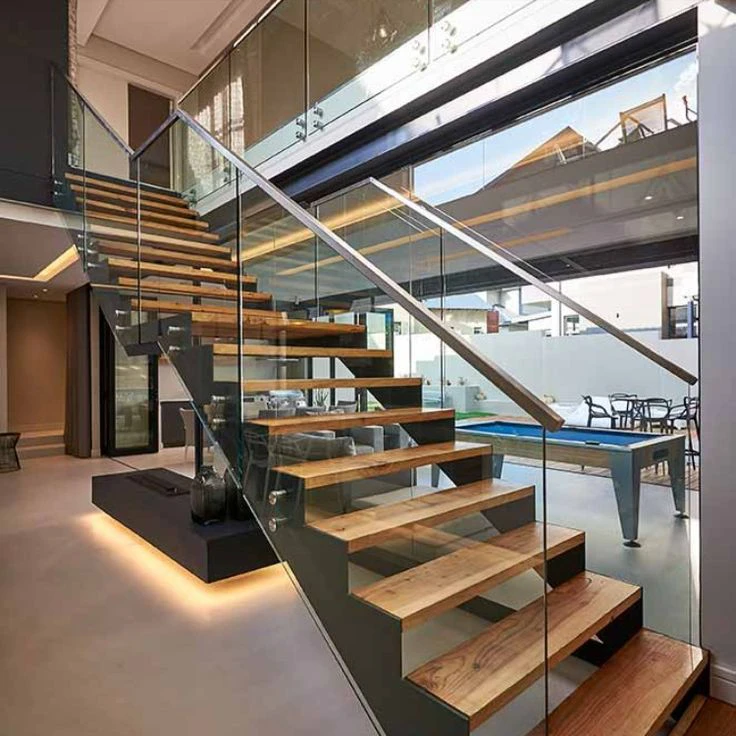
-
Aesthetically pleasing:
Floating staircases are popular for their sleek, modern, and contemporary design that adds an elegant touch to any space. They create a feeling of openness, spaciousness, and lightness, making the area look larger and more inviting. This staircase does give the illusion of floating. The are space savers and light.
-
Design flexibility:
Various shapes as straight, dogleg, u shape and curved floating staircases are possible.
-
Restrictions:
The width of the timber stairs and landing should not be more than 1m. The thickness of the timber should not be less than 40mm. Keep the traffic to a minimum at one time. The stainless-steel balustrade handrail to be 50 diameter stainless-steel.
-
Natural light:
The open design of a floating staircase allows natural light to flow through the space, creating a bright and airy atmosphere.
-
Easy to clean:
The open design of floating staircases makes them easy to clean, as there are no enclosed areas that can accumulate dirt or dust.
-
Noise and movement:
Because floating staircases don't have any support underneath, could produce more noises and movement when walked on than traditional stairs. Solid steel bars securing the stairs and landing to the wall by means of epoxy, plus a strong stainless-steel balustrade can form a structural stringer to add enough strength to the floating staircase. A double stainless-steel spacer between the stairs will make the staircase very sturdy.
-
Building codes:
The wall needs to be at least a double wall. Some local building codes may not allow floating staircases due to safety concerns. Therefore, it's important to check your local building codes before installing a floating staircase.
HELIX STAIRCASE
A helix staircase is a special kind of stairs that looks cool and modern. They make a room look bigger and brighter. But they take up a lot of space, so they need to be planned carefully before building them. They can be made in different sizes and have handrails on both sides. Making a helix staircase is harder than making regular stairs, so it can be more expensive.
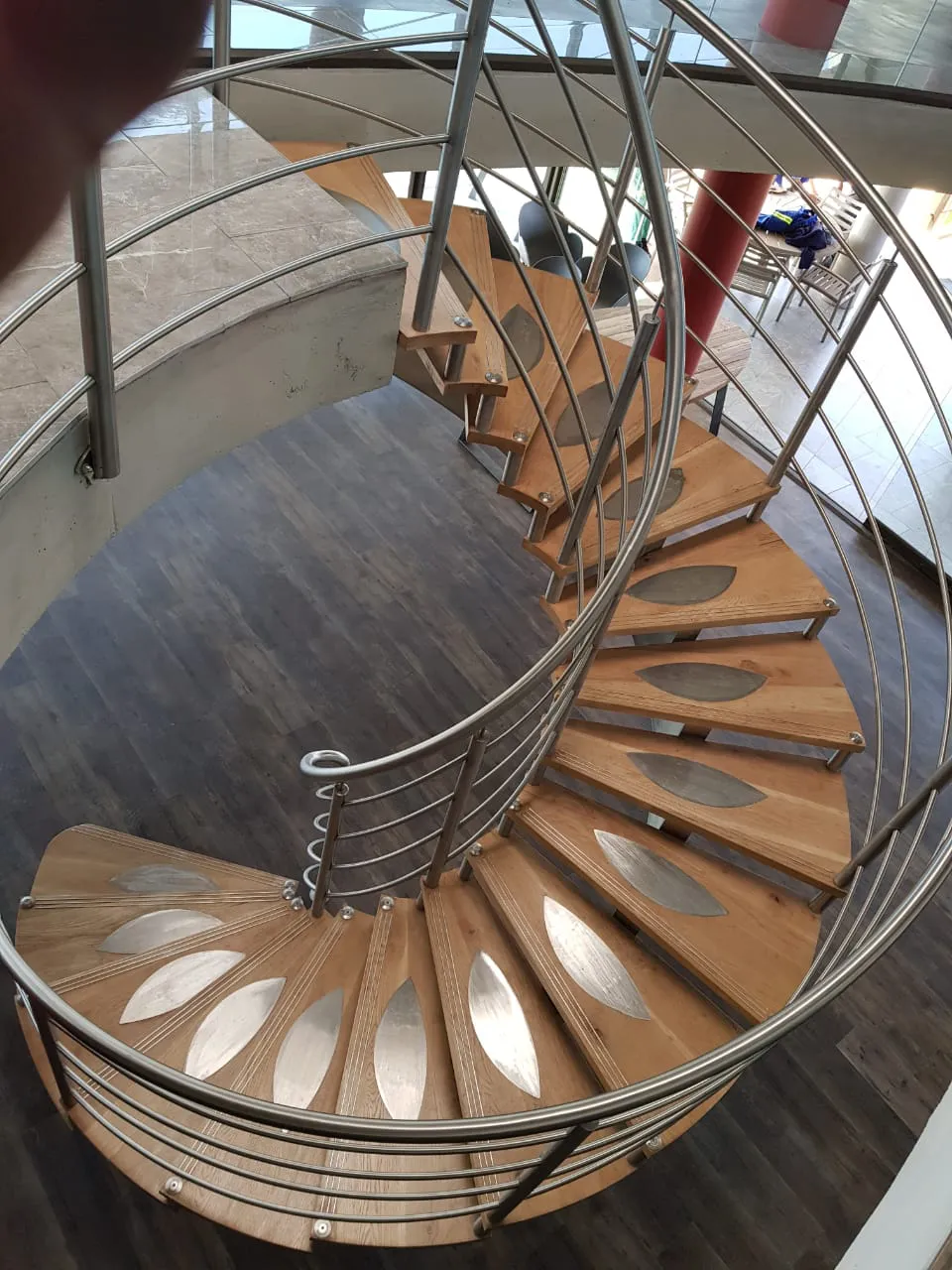
-
Aesthetically pleasing:
Floating staircases are popular for their sleek, modern, and contemporary design that adds an elegant touch to any space. They create a feeling of openness, spaciousness, and lightness, making the area look larger and more inviting. This staircase does give the illusion of floating. The are space savers and light.
-
Natural light:
The open design of a helix staircase allows natural light to flow through the space, creating a bright and airy atmosphere.
-
Easy to clean:
The open design of helix staircases makes them easy to clean, as there are no enclosed areas that can accumulate dirt or dust.
-
Space grabber:
Please note that the helix staircase is a space grabber and must be planned into the design of a building and not an aftermath. They take up a considerable amount of space as the going on the outer side is usually much more than that of the inner side.
-
Design flexibility:
Helix stairs generally have a handrail on both sides with an even stair. The stairs are uniform whilst following the helix curve. Stringers are usually singular flowing down the centre of the stairs and landing. Curved plates on either side can also make up the stringers. The winding shape may be big or small.
-
Higher cost:
A helix staircase can be more expensive to design, and build compared to traditional staircase. They are costly to manufacture and take a lot of skill and time to perfect.
SPIRAL STAIRCASE
There is something called a "spiral staircase" which is a special type of staircase. It is made in a round shape and the stairs are very close together. This means that it can fit in small spaces and can be pretty to look at with different materials like wood, metal, or glass.
It's also easier to put together than other staircases because it can be built in pieces and then assembled where it needs to go. But because the stairs are so close together, it can be hard to climb for some people, especially if they have trouble with balance or walking.
And while it saves space, it can be a bit tricky to move big things up and down because the staircase is so small. So, it's great for saving space, but not the best for everyone to use.
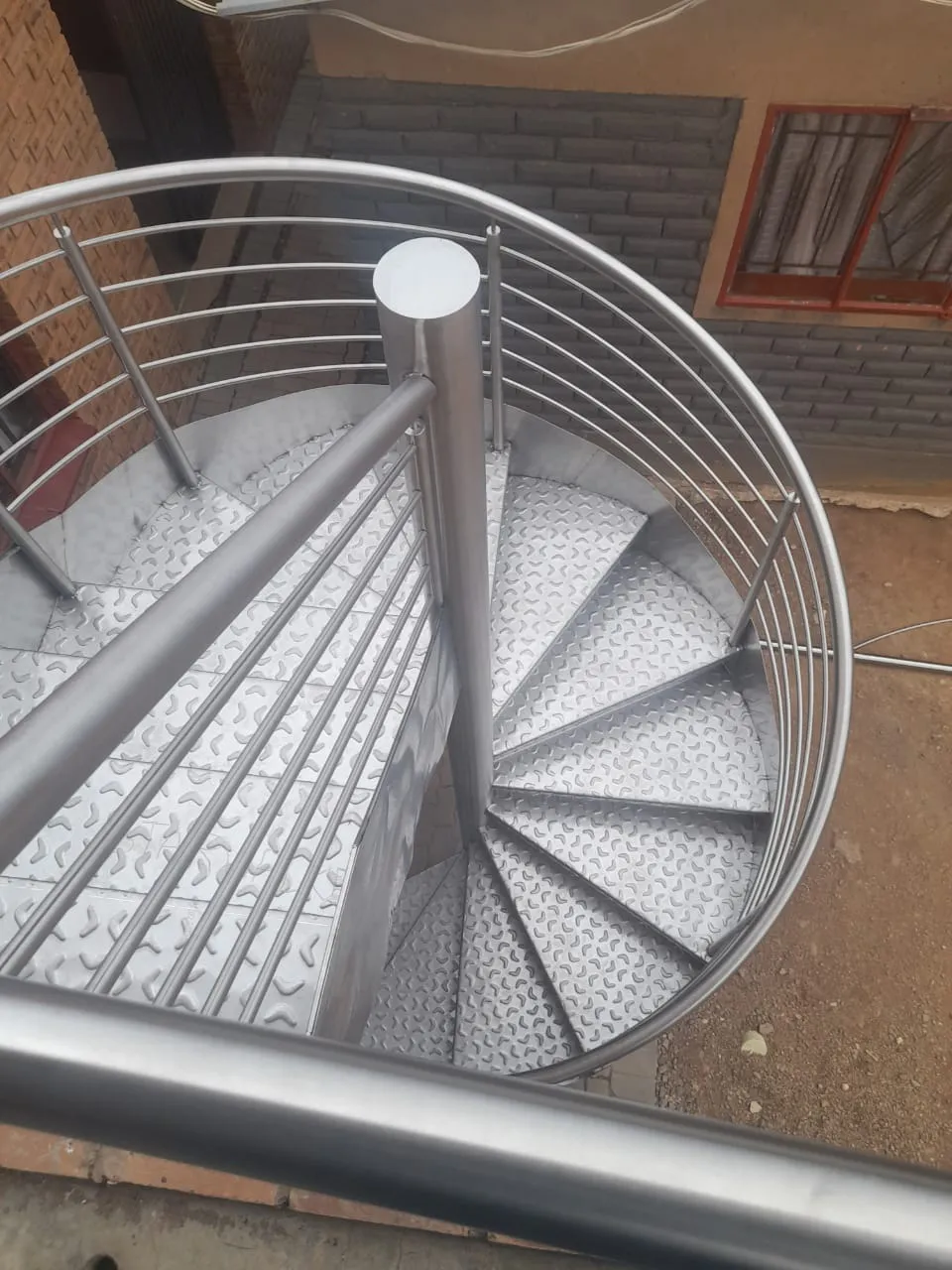
-
Aesthetically pleasing:
Spiral staircases can be visually stunning and add a unique touch to any space. They come in a variety of styles and materials, such as timber or steel checker plate. The balustrade is stainless-steel. The centre-pole is steel.
-
Space-saving:
Spiral staircases are popular for their compact design, making them an excellent choice for small homes or spaces where there is limited room for a traditional staircase.
-
Easy to install:
Spiral staircases are relatively easy to install compared to traditional staircases. They can be prefabricated and assembled on-site, making them a great option for a quick installation.
-
Natural light:
The open design of a spiral staircase allows natural light to flow through the space, creating a bright and airy atmosphere.
-
Easy to clean:
The open design of spiral staircases makes them easy to clean, as there are no enclosed areas that can accumulate dirt or dust.
-
Flexible design:
Spiral staircases are available in various diameters.
-
Restrictions:
The width of the stairs should not be more than 1m. The stainless-steel balustrade handrail to be 50 diameter stainless-steel. Head clearance should not be less than 2,1m. Rise should be as close to 200mm, but not more. 11-12 stairs in a full circle. A stainless-steel spacer between the stairs will make the staircase very sturdy.
-
Steep stairs:
Spiral staircases are known for their narrow stairs and steep angle, which can make them difficult to navigate for some people, especially those with mobility issues or balance problems. The steep angle is necessary to provide enough head clearance.
-
Limited space:
While spiral staircases are space-saving, the small size of the stairs can be a disadvantage for moving furniture or other large items up and down the stairs.
PROP-SPIRAL STAIRCASE
There is something called a "prop-spiral staircase" which is a special type of staircase. It is made in a round shape and the stairs are very close together. This means that it can fit in small spaces and can be pretty to look at with different materials like wood, metal, or glass.
It's also easier to put together than other staircases because it can be built in pieces and then assembled where it needs to go. But because the stairs are so close together, it can be hard to climb for some people, especially if they have trouble with balance or walking.
And while it saves space, it can be a bit tricky to move big things up and down because the staircase is so small. So, it's great for saving space, but not the best for everyone to use.
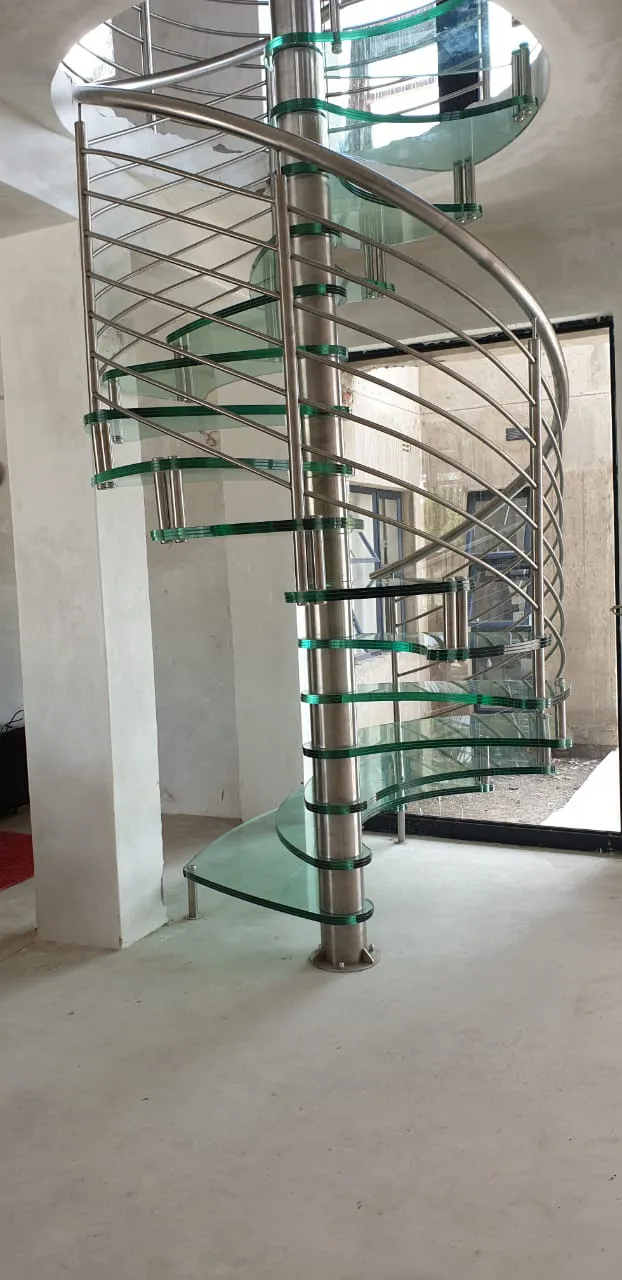
-
Space-saving:
Prop spiral staircases are popular for their compact design, making them an excellent choice for small homes or spaces where there is limited room for a traditional staircase.
-
Aesthetically pleasing:
Prop-spiral staircases can be visually stunning and add a unique touch to any space. They come in a variety of styles and materials, such as timber or glass. The balustrade and centre-pole are stainless-steel.
-
Easy to install:
Prop-spiral staircases are relatively easy to install compared to traditional staircases. They can be prefabricated and assembled on-site, making them a great option for a quick installation. The stringer is sliced in equally spaced sections. This staircase has a hidden central section which ties the whole staircase together.
-
Natural light:
The open design of a prop-spiral staircase allows natural light to flow through the space, creating a bright and airy atmosphere.
-
Easy to clean:
The open design of prop-spiral staircases makes them easy to clean, as there are no enclosed areas that can accumulate dirt or dust.
-
Flexible design:
Prop-spiral staircases are available in various diameters.
-
Restrictions:
The width of the stairs should not be more than 1m. The stainless-steel balustrade handrail to be 50 diameter stainless-steel. Head clearance should not be less than 2,1m. Rise should be as close to 200mm, but not more. 11-12 stairs in a full circle. A stainless-steel spacer between the stairs will make the staircase very sturdy.
-
Steep stairs:
Prop-spiral staircases are known for their narrow stairs and steep angle, which can make them difficult to navigate for some people, especially those with mobility issues or balance problems. The steep angle is necessary to provide enough head clearance.
-
Limited space:
While prop-spiral staircases are space-saving, the small size of the stairs can be a disadvantage for moving furniture or other large items up and down the stairs.
HANGING STAIRCASE
Have you ever seen stairs that look like they are floating in the air? Those are called hanging staircases. They are special stairs that are supported by metal rods or cables instead of having a solid base under each step like regular stairs. Hanging staircases look really cool and modern, and they can be used in small spaces because they don't take up as much room as regular stairs. They also let in a lot of natural light and are easy to clean. But hanging staircases can be more expensive to make than regular stairs, and they must be built very carefully to be safe. Sometimes they can make noise when people walk on them, and they might not be able to hold heavy things.
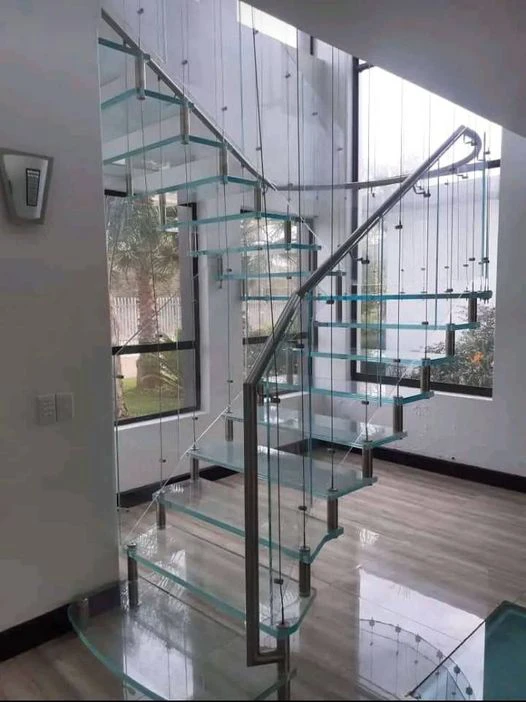
-
Aesthetics:
Hanging staircases are often visually striking and can add a unique and modern element to a building's design. They are ideal for contemporary or minimalist architecture.
-
Space-saving:
Hanging staircases can be a space-saving solution, as they do not require the same amount of floor space as traditional staircases. This makes them ideal for small or narrow spaces.
-
Natural light:
The open design of a hanging staircase allows natural light to flow through the space, creating a bright and airy atmosphere.
-
Easy to clean:
The open design of hanging staircases makes them easy to clean, as there are no enclosed areas that can accumulate dirt or dust.
-
Cost:
Hanging staircases can be more expensive to install than traditional staircases, as they require specialized materials and installation methods.
-
Safety:
Hanging staircases require careful design and construction to ensure that they are safe and structurally sound. There is a risk of injury if the cables or rods supporting the staircase are not installed properly or if they become damaged.
-
Noise:
The metal components of a hanging staircase can create noise as people walk up and down the stairs. This can be a problem in quiet environments, such as libraries or residential buildings.
-
Steep stairs:
Prop-spiral staircases are known for their narrow stairs and steep angle, which can make them difficult to navigate for some people, especially those with mobility issues or balance problems. The steep angle is necessary to provide enough head clearance.
-
Limited weight capacity:
Hanging staircases may have a limited weight capacity, which can be a disadvantage in commercial or industrial settings where heavy equipment or materials need to be transported up and down the stairs.









